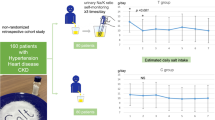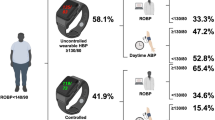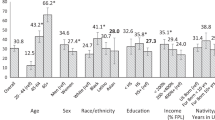Abstract
We investigated a simple device to monitor daily salt intake at home and examined the relationship between salt excretion and morning blood pressure in order to enable patients to better manage daily salt intake and hypertension. The correlation between 24-h urinary salt excretion and measured value with salt monitor from overnight urine was significant (n=224, r=0.72, P<0.001). A total of 46 volunteers participated for more than 3 weeks by measuring daily salt intake and morning blood pressure. The relationship between predicted daily salt excretion and blood pressure was examined with use of 3-day moving average. Mean salt excretion and systolic blood pressure (SBP) significantly decreased by the end of the trial (i.e., salt excretion decreased from 158±31 to 149±30 mmol/day and SBP from 137±17 to 133±16 mm Hg). Of 46 participants, 18 (39%) had a significant correlation between predicted daily salt excretion and blood pressure (r>0.4, P<0.05, n>21), indicating sodium sensitivity. An additional 17% had a positive correlation that did not reach statistical significance (0.2<r⩽0.4), and the remaining 44% had no correlation (r⩽0.2). Mean decrease in blood pressure per decrease in salt (g) (17 mmol) intake in the 18 participants with a significant correlation was 3.3 mm Hg (SBP) and 1.5 mm Hg (diastolic blood pressure), which was higher than that reported for other studies. Hypertensive patients not using medication showed the largest decrease. We conclude that daily monitoring of salt intake and morning blood pressure will be useful for management of hypertension.
This is a preview of subscription content, access via your institution
Access options
Subscribe to this journal
Receive 12 digital issues and online access to articles
$119.00 per year
only $9.92 per issue
Buy this article
- Purchase on Springer Link
- Instant access to full article PDF
Prices may be subject to local taxes which are calculated during checkout



Similar content being viewed by others
References
Intersalt Cooperative Research Group.Intersalt: an international study of electrolyte excretion and blood pressure. Results for 24-hour urinary sodium and potassium excretion. BMJ 1988; 297: 319–328.
Law MR, Frost CD, Wald NJ . By how much does dietary salt reduction lower blood pressure? BMJ 1991; 302: 811–823.
Chobanian AV, Hill M . National Heart, Lung, and Blood Institute Workshop on sodium and blood pressure. Hypertension 2000; 35: 858–863.
Labarthe D, Ayala C . Nondrug interventions in hypertension prevention and control. Cardiol Clin 2002; 20: 249–263.
Whelton PK, He J, Appel LJ, Cutler JA, Havas S, Kotchen TA et al. Primary prevention of hypertension: Clinical and Public Health Advisory from the National High Blood Pressure Education Program. JAMA 2002; 288 (15): 1882–1888.
Nagata C, Takatsuka N, Shimizu N, Shimizu H . Sodium intake and risk of death from stroke in Japanese men and women. Stroke 2004; 35: 1543–1547.
Khaw KT, Bingham S, Welch A, Luben R, O’Brien E, Wareham N et al. Blood pressure and urinary sodium in men and women: the Norfolk Cohort of the European Prospective Investigation into Cancer (EPIC-Norfolk). Am J Clin Nutr 2004; 80 (5): 1397–1403.
He FJ, Markandu ND, MacGregor GA . Modest salt reduction lowers blood pressure in isolated systolic hypertension and combined hypertension. Hypertension 2005; 46 (1): 66–70.
Joossens JV, Hill MJ, Elliott P, Stamler R, Lesaffre E, Dyer A et al. Dietary salt, nitrate and stomach cancer mortality in 24 countries. Int J Epidemiol 1996; 25 (3): 494–504.
Tsugane S, Sasazuki S, Kobayashi M, Sasaki S . Salt and salted food intake and subsequent risk of gastric cancer among middle-aged Japanese men and women. Br J Cancer 2004; 90: 128–134.
Chobanian AV, Bakris GL, Black HR, Cushman WC, Green LA, Izzo JL et al. National High Blood Pressure Education Program Coordinating Committee. Seventh Report of the Joint National Committee on Prevention, Detection, Evaluation, and Treatment of High Blood Pressure (JNC-7). Hypertension 2003; 42: 1206–1252.
Pietinen P . Estimating sodium intake from food consumption data. Ann Nutr Metab 1982; 26: 90–99.
Holbrook JT, Patterson KY, Bodner JE, Dougras LW, Veillon C, Kelsay JL et al. Sodium and potassium intake and balance in adults consuming self-selected diets. Am J Clin Nutr 1984; 40 (4): 786–793.
Simpson FO . Sodium intake, body sodium, and sodium excretion. Lancet 1988, 25–28.
Kawasaki T, Itoh K, Uezono K, Sasaki H . A simple method for estimating 24 h urinary sodium and potassium excretion from second morning voiding urine specimen in adults. Clin Exp Pharmacol Physiol 1993; 20 (1): 7–14.
Tanaka T, Okamura T, Miura K, Kadowaki T, Ueshima H, Nakagawa H, Hashimoto T . A simple method to estimate populational 24-h urinary sodium and potassium excretion using a casual urine specimen. J Hum Hypertens 2002; 16 (2): 97–103.
Kamata K, Tochikubo O . Estimation of urinary sodium excretion using lean body mass and overnight urine collected by a pipe-sampling method. J Hypertens 2002; 20: 2191–2197.
Luft FC, Fineberg NS, Sloan RN . Overnight urine collections to estimate sodium intake. Hypertension 1982; 4: 494–498.
Knuiman JT, Poppel GV, Burema J, Heijden L, Hautivast JGAG . Multiple overnight urine collections may be used for estimating the excretion of electrolytes. Clin Chem 1988; 34 (1): 135–138.
He J, Klag MJ, Whelton PK, Chen JY, Mo JP, Qian MC et al. Agreement between overnight and 24-hour urinary cation excretions in Southern Chinese men. Am J Epidemiol 1993; 137: 1212–1220.
Tochikubo O, Sasaki O, Umemura S, Kaneko Y . Management of hypertension in high school students by using new salt titrator tape. Hypertension 1986; 8: 1164–1171.
Fujita T, Henry WL, Barter FC, Lake CR, Delea CS . Factors influencing blood pressure in salt-sensitive patients with hypertension. Am J Med 1980; 69: 334–344.
Weinberger MH, Miller JZ, Luft FC, Grim CE, Fineberg NS . Definitions and characteristics of sodium sensitivity and blood pressure resistance. Hypertension 1986; 8 (6): 127–134.
Hunt SC, Cook NR, Oberman A, Culter JA, Hennekens CH, Allender PS et al. Angiotensinogen genotype, sodium reduction, weight loss, and prevention of hypertension – trials of hypertension prevention, Phase II. Hypertension 1998; 32: 393–401.
Osanai T, Okuguchi T, Kamada T, Fujiwara N, Kosugi T, Saitoh G et al. Salt-induced exacerbation of morning surge in blood pressure in patients with essential hypertension. J Hum Hypertens 2000; 14 (1): 57–64.
Kario K, Pickering TG, Umeda Y, Hoshide S, Hoshide Y, Morinari M et al. Morning surge in blood pressure as a predictor of silent and clinical cerebrovascular disease in elderly hypertensives: a prospective study. Circulation 2003; 107 (10): 1401–1406.
He FJ, MacGregor GA . How far should salt intake be reduced? Hypertension 2003; 42: 1093–1099.
Staessen J, Broughton PM, Fletcher AE, Markowe HL, Marmot MG, Rose G et al. The assessment of the relationship between blood pressure and sodium intake using whole-day, daytime and overnight urine collections. J Hypertens 1991; 9 (11): 1035–1040.
Luft FC, Fineberg NS, Sloan RS . Estimating dietary sodium intake in individuals receiving a randomly fluctuating intake. Hypertension 1982; 4 (6): 805–808.
Liu K, Dyer AR, Cooper RS, Stamler R, Stamler J . Can overnight urine replace 24-hour urine collection to asses salt intake? Hypertension 1979; 1: 529–536.
Giaconi S, Ghione S, Palombo C, Genovesi-Ebert A, Marabotti C, Fommei E et al. Seasonal influences on blood in high normal to mild hypertensive range. Hypertension 1989; 14: 22–27.
Murakami S, Otsuka K, Kubo Y, Shinagawa M, Yamanaka T, Ohkawa S et al. Repeated ambulatory monitoring reveals a Monday morning surge in blood pressure in a community-dwelling population. Am J Hypertens 2004; 17: 1179–1183.
Sacks FM, Svetky LP, Vollmer WM, Appel LJ, Bray GA, Harsha D et al. DASH – Sodium Collaborate Research Group. Effects on blood pressure of reduced dietary sodium and the dietary approaches to stop hypertension (DASH) diet. N Engl J Med 2001; 344 (1): 3–10.
Acknowledgements
We express our gratitude to Dr Kouichi Hirao of HEC Science Clinic for obtaining data used in our study. This study was supported in part by the Japan Health and Research Institute.
Author information
Authors and Affiliations
Corresponding author
Rights and permissions
About this article
Cite this article
Yamasue, K., Tochikubo, O., Kono, E. et al. Self-monitoring of home blood pressure with estimation of daily salt intake using a new electrical device. J Hum Hypertens 20, 593–598 (2006). https://doi.org/10.1038/sj.jhh.1002049
Received:
Revised:
Accepted:
Published:
Issue Date:
DOI: https://doi.org/10.1038/sj.jhh.1002049
Keywords
This article is cited by
-
Dietary salt intake in Japan - past, present, and future
Hypertension Research (2022)
-
Practical and personal education of dietary therapy in hypertensive patients
Hypertension Research (2020)
-
Self-monitoring urinary salt excretion device can be used for controlling hypertension for developing countries
Clinical Hypertension (2019)
-
Effects of self-monitoring of daily salt intake estimated by a simple electrical device for salt reduction: a cluster randomized trial
Hypertension Research (2018)
-
Urinary sodium excretion and risk of cardiovascular disease in the Chinese population: a prospective study
Hypertension Research (2018)



